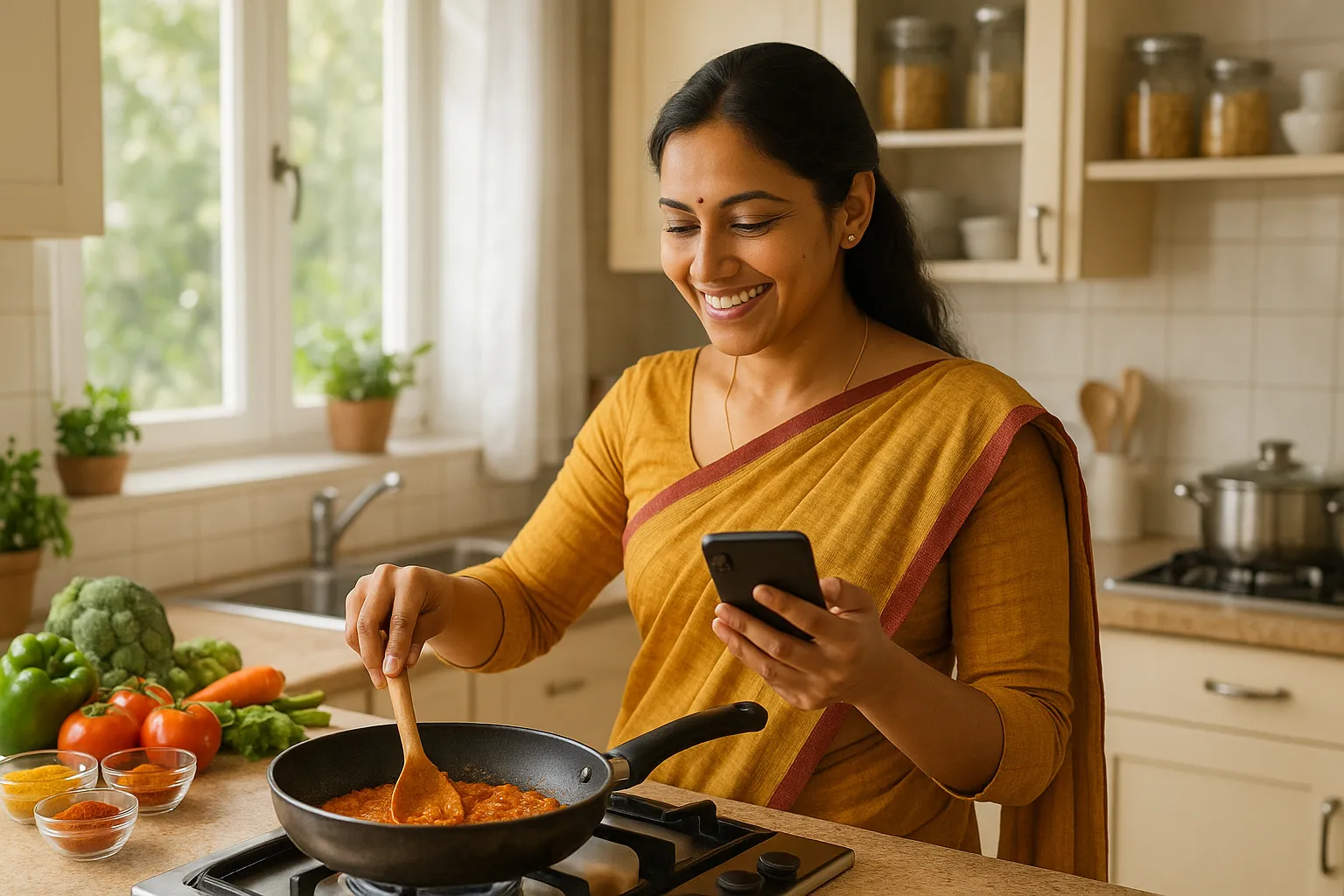.avif)
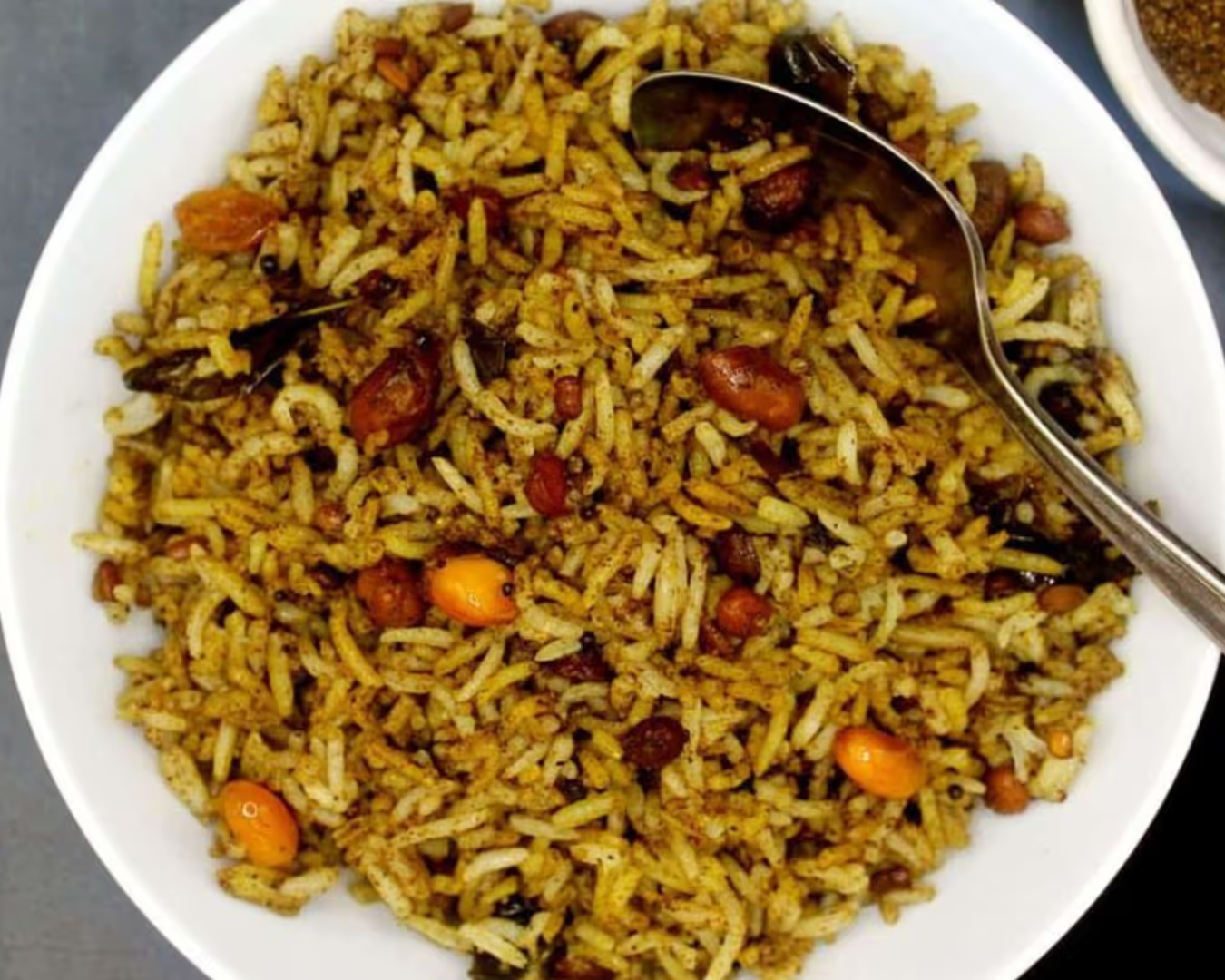
History: Iyengar Puliyodarai has been a treasured offering in Iyengar Brahmin temples and homes for centuries, symbolising devotion and purity, with recipes passed meticulously from one generation to the next.
Cuisine: This tangy tamarind rice dish blends cooked rice with a spice-rich tamarind paste, tempered in sesame oil, making it a staple during festivals, temple feasts and special family gatherings.
Role of Spices: Tamarind, dry red chillies, fenugreek, coriander seeds, and curry leaves form its core, giving Puliyodarai its unique aroma and deep, lingering taste that defines Iyengar culinary heritage.
History: Rooted in the coastal traditions of Goa, Saraswat Fish Curry has evolved over centuries, adapting local ingredients while preserving the community’s vegetarian-on-festival-day rules and fish-rich daily diet.
Cuisine: This coconut-based curry, enhanced with kokum for tanginess, uses fresh-caught fish and delicate spices, reflecting the Saraswat balance of mild heat, sea freshness, and wholesome nourishment.
Role of Spices: Mustard seeds, coriander, cumin, turmeric, and kokum are key, harmonising coastal produce with spices that highlight the freshness of the fish without overpowering its natural flavors.
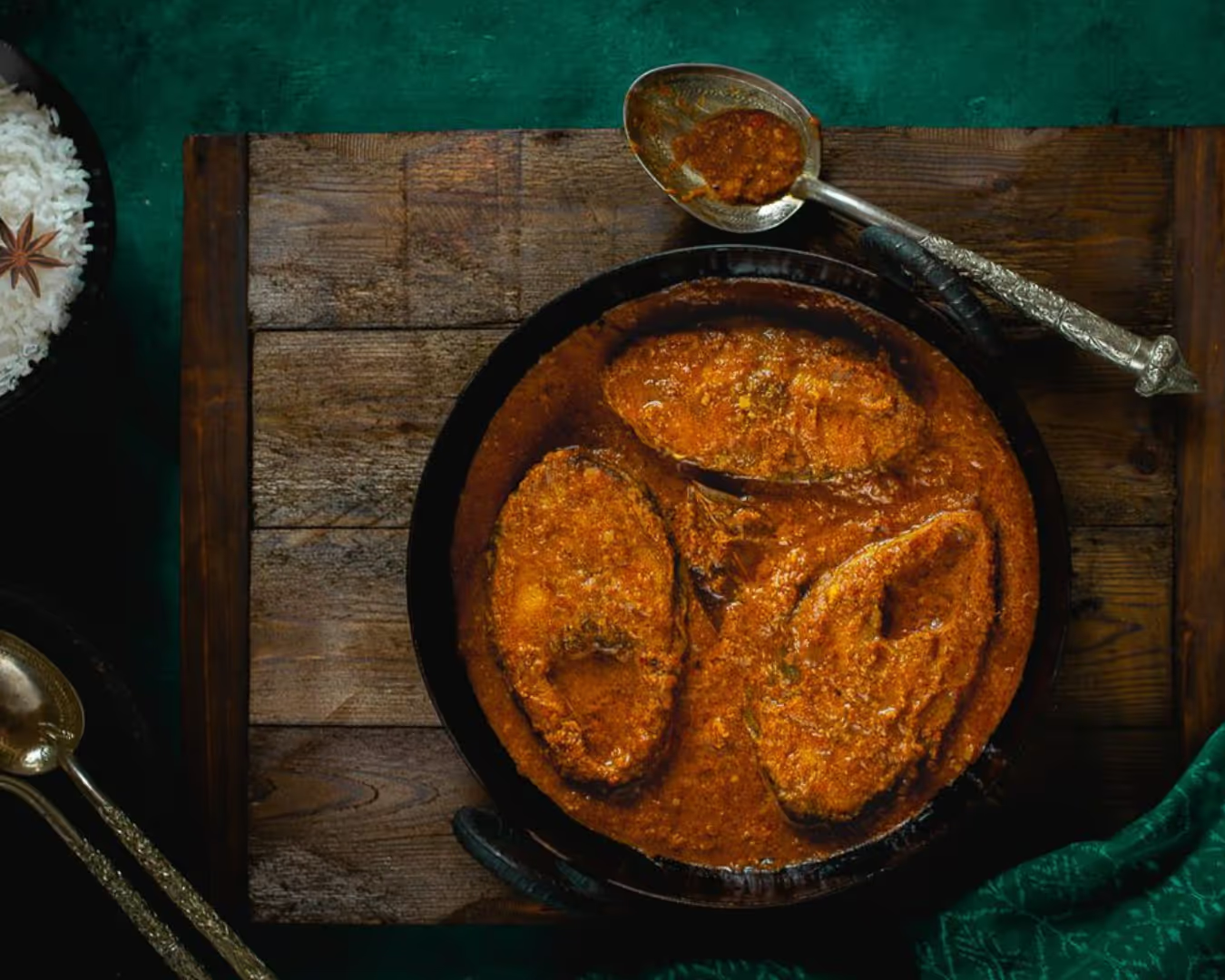
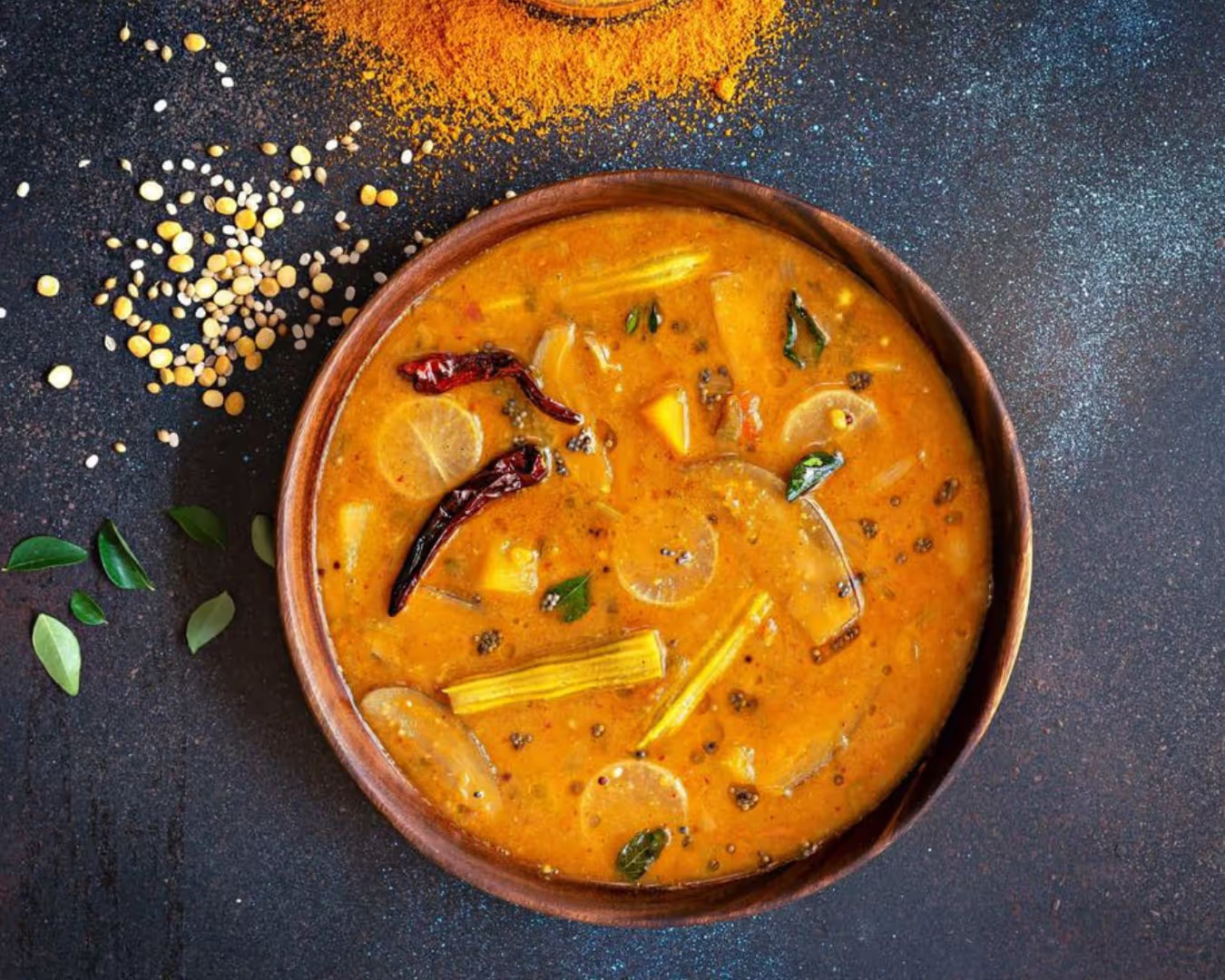
History: Palakkad Iyer Sambar originates from the Tamil community settled in Kerala, merging Tamil spice profiles with Kerala’s coconut-rich influence in a unique regional hybrid.
Cuisine: Made with toor dal, tamarind, vegetables, and freshly ground coconut masala, it stands apart from Tamil Nadu’s sambar with its richer, creamier body and aromatic freshness.
Role of Spices: Coriander seeds, dried red chillies, fenugreek, curry leaves, and coconut form the backbone, delivering a distinctive fragrance that defines Palakkad Iyer culinary identity.
History: Puran Poli has been the pride of Deshastha kitchens for centuries, an essential part of Holi, Gudi Padwa, and Ganesh Chaturthi celebrations, signifying prosperity and joy.
Cuisine: A soft flatbread stuffed with sweetened chana dal filling, flavored with cardamom and nutmeg, prepared with precision and served with generous ghee for festive indulgence.
Role of Spices: Nutmeg, cardamom, and saffron add depth and fragrance, transforming the simple combination of jaggery and lentils into a dessert that is celebratory and memorable.
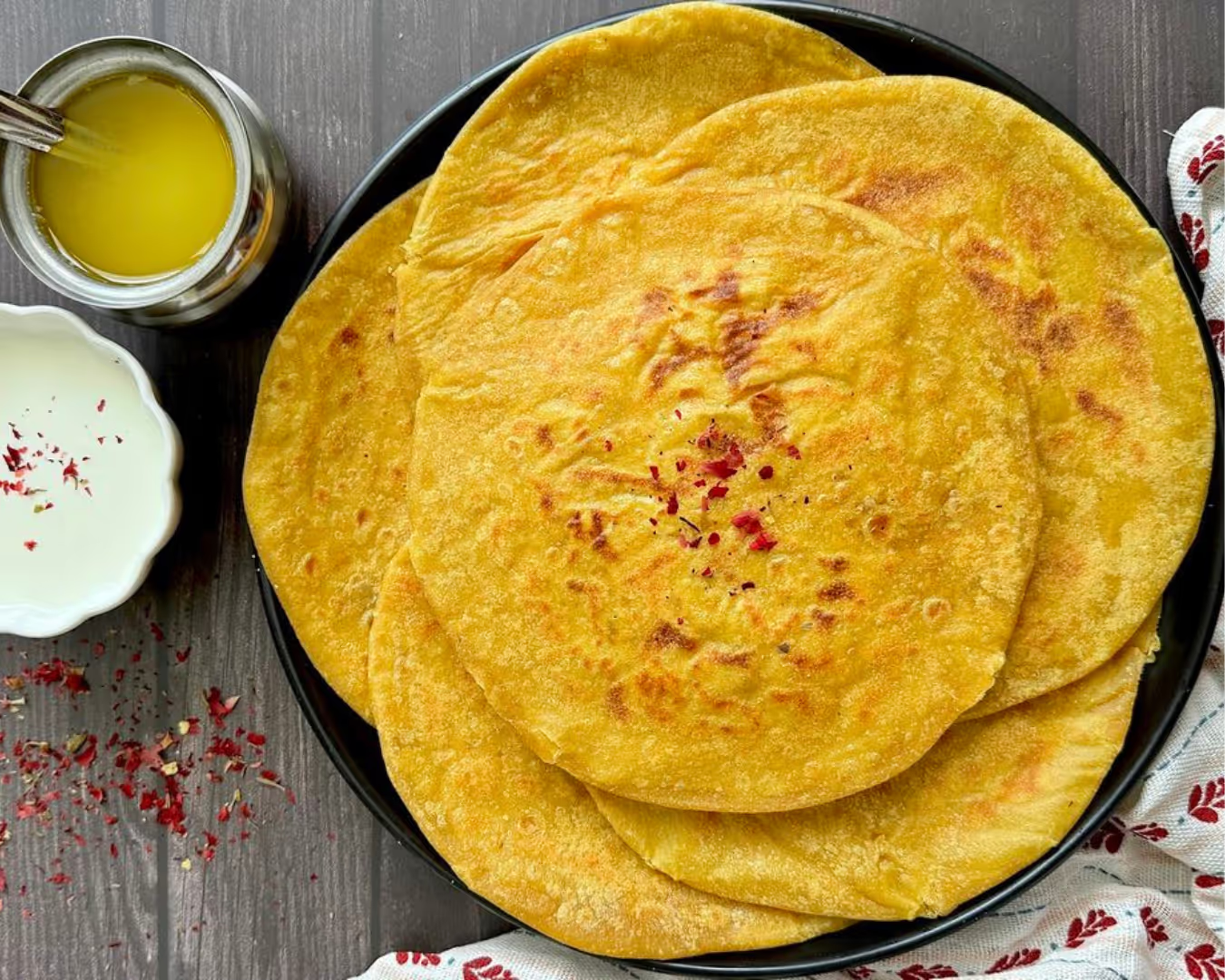

History: Born in the Shekhawati region, this dish sustained warriors and farmers, later refined in royal Rajput kitchens into a festive and opulent meal.
Cuisine: Ghee-laden baked wheat balls are served with spiced lentil curry and sweet churma, offering a complete spectrum of savoury, spicy, and sweet in a single platter.
Role of Spices: Cumin, coriander, turmeric, and red chilli powder provide depth to the dal, enhancing its earthy richness while complementing the hearty baati and sweet churma.
History: Kashmiri Dum Aloo emerged from the community’s unique vegetarian repertoire, retaining authenticity by avoiding onions and garlic while maintaining rich, aromatic gravies.
Cuisine: Baby potatoes are fried and simmered in yoghurt-based gravy, richly coloured with Kashmiri chilli powder, creating a dish that is both vibrant and delicately spiced.
Role of Spices: Kashmiri chilli, fennel powder, dry ginger powder, and asafoetida are integral, imparting aroma, heat and the signature red hue without overpowering the palate.
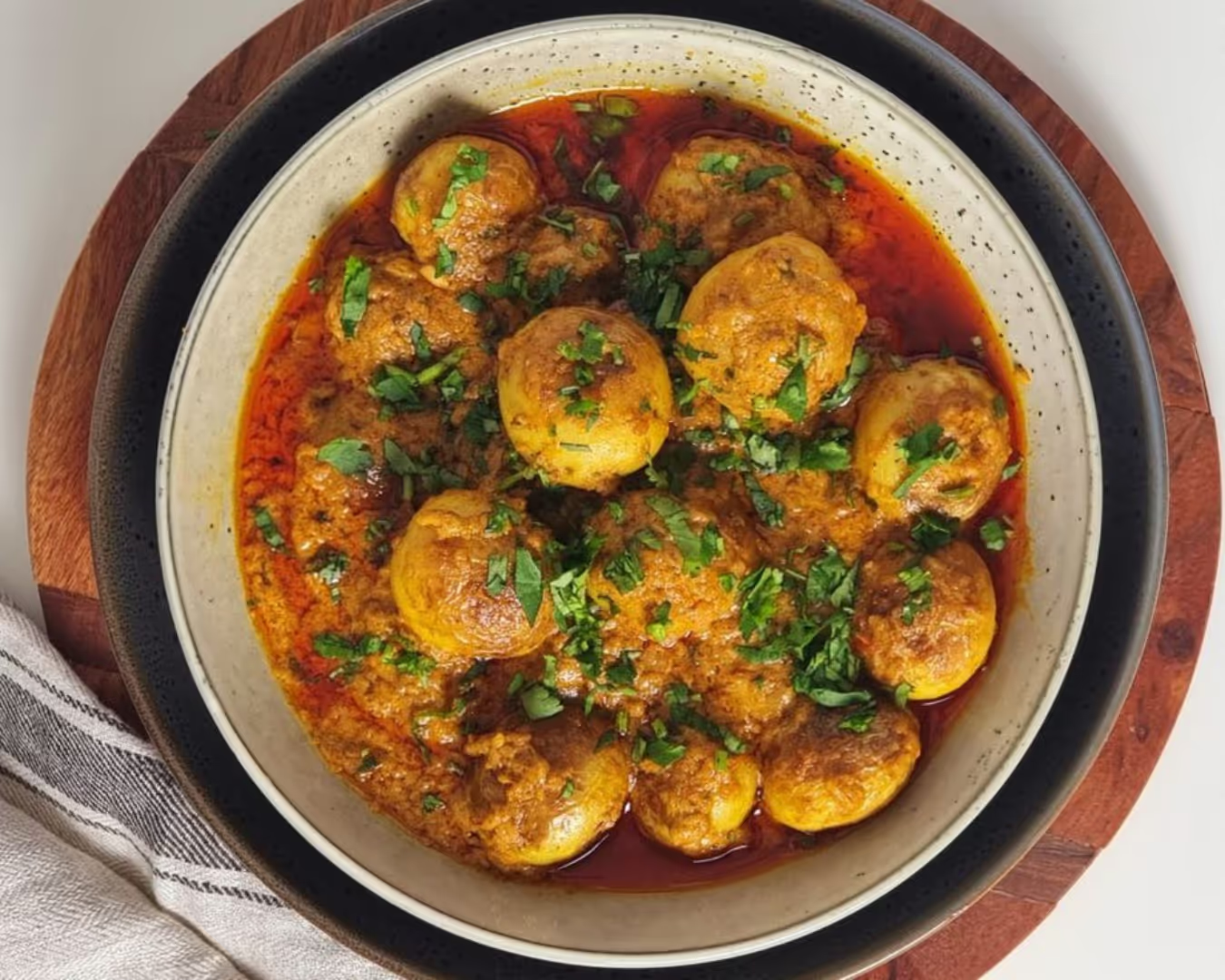
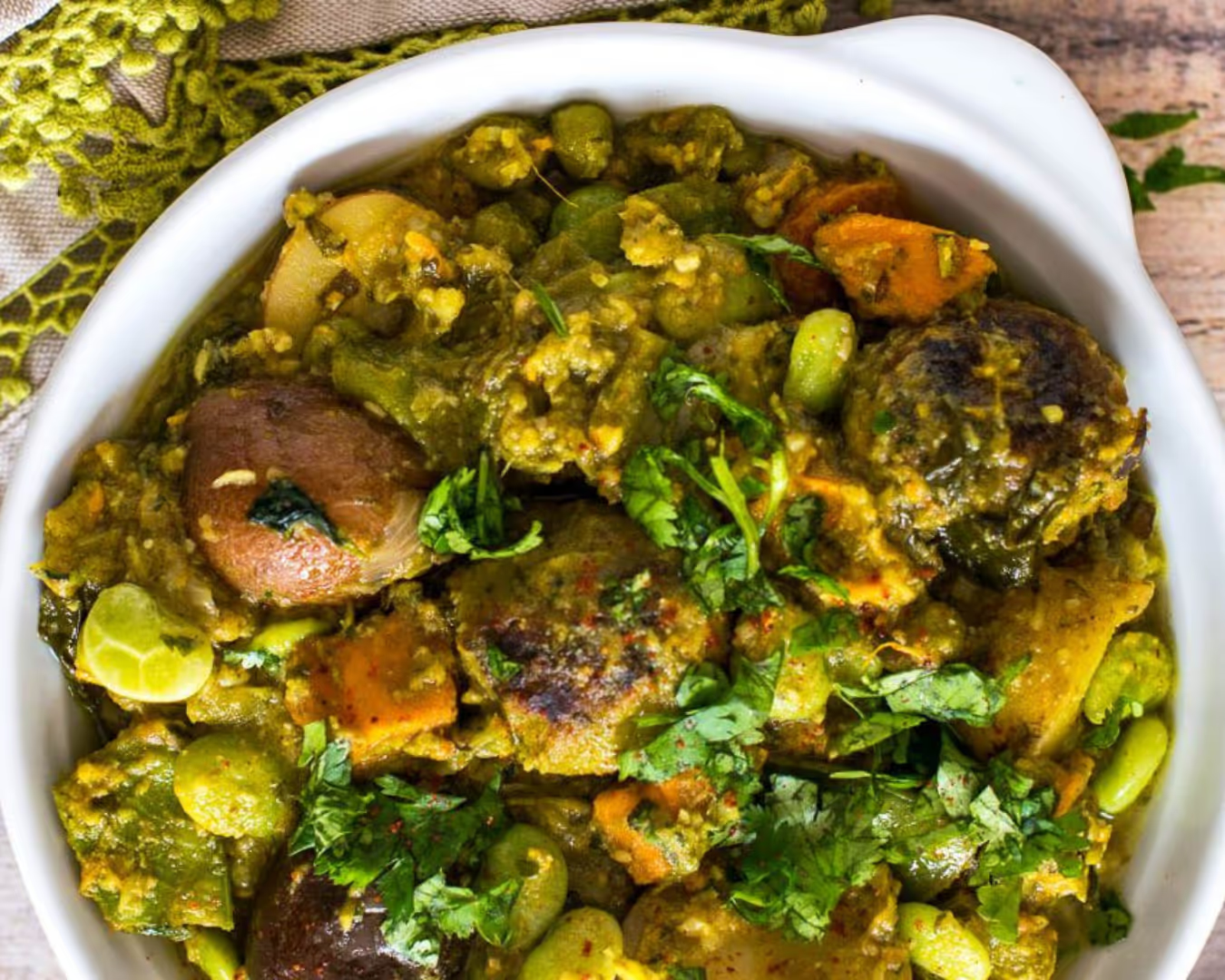
History: Undhiyu is a traditional winter delicacy of Gujarati Hindu families, historically cooked underground in earthen pots, bringing communities together during harvest season celebrations.
Cuisine: A slow-cooked medley of seasonal vegetables, fenugreek dumplings, and spices, it showcases Gujarat’s knack for balancing sweet, spicy, and tangy elements in one dish.
Role of Spices: Coriander, cumin, sesame seeds, ajwain, and fresh green masala define its complex yet comforting flavor, deeply rooted in Gujarat’s festive food heritage.
History: Kadai Paneer reflects the hearty, bold style of Punjabi Hindu kitchens, where dairy-rich vegetarian fare balances spice and indulgence.
Cuisine: Paneer cubes are cooked in a thick tomato-onion gravy with bell peppers, enriched by coarsely ground spice blends for signature texture and aroma.
Role of Spices: Coriander seeds, dried red chillies, ginger, and garam masala are freshly ground, giving this dish its rustic punch and irresistible fragrance.
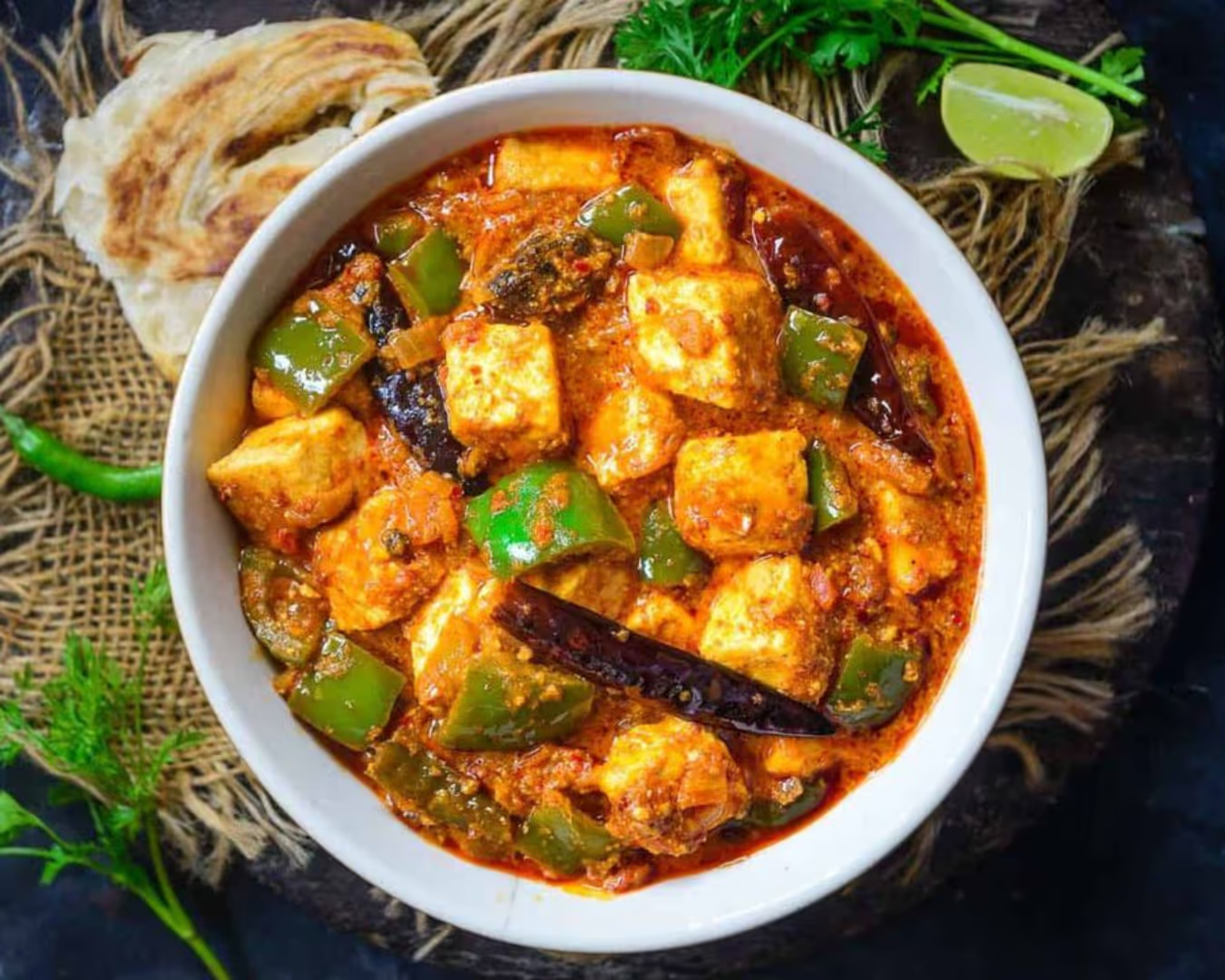
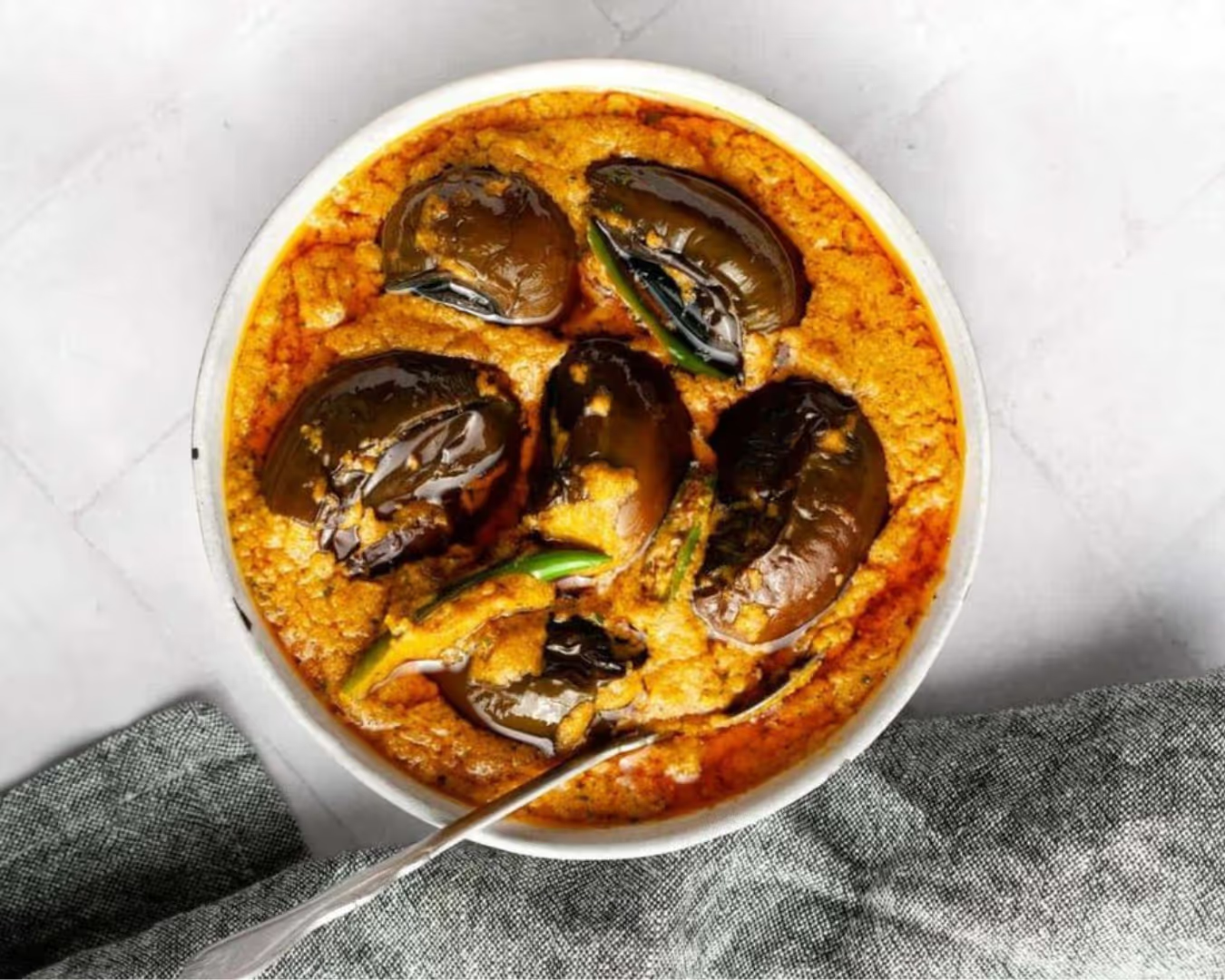
History: Bagara Baingan, though associated with Hyderabad, is cherished in many Hindu households in Telangana, especially during festivals and special gatherings.
Cuisine: Small brinjals are stuffed with a spice-coconut-peanut paste, simmered in tangy tamarind gravy, creating a rich, layered flavour profile.
Role of Spices: Coriander seeds, cumin, sesame, dried coconut, and tamarind balance heat, tanginess and nuttiness, making it a dish of celebratory richness.
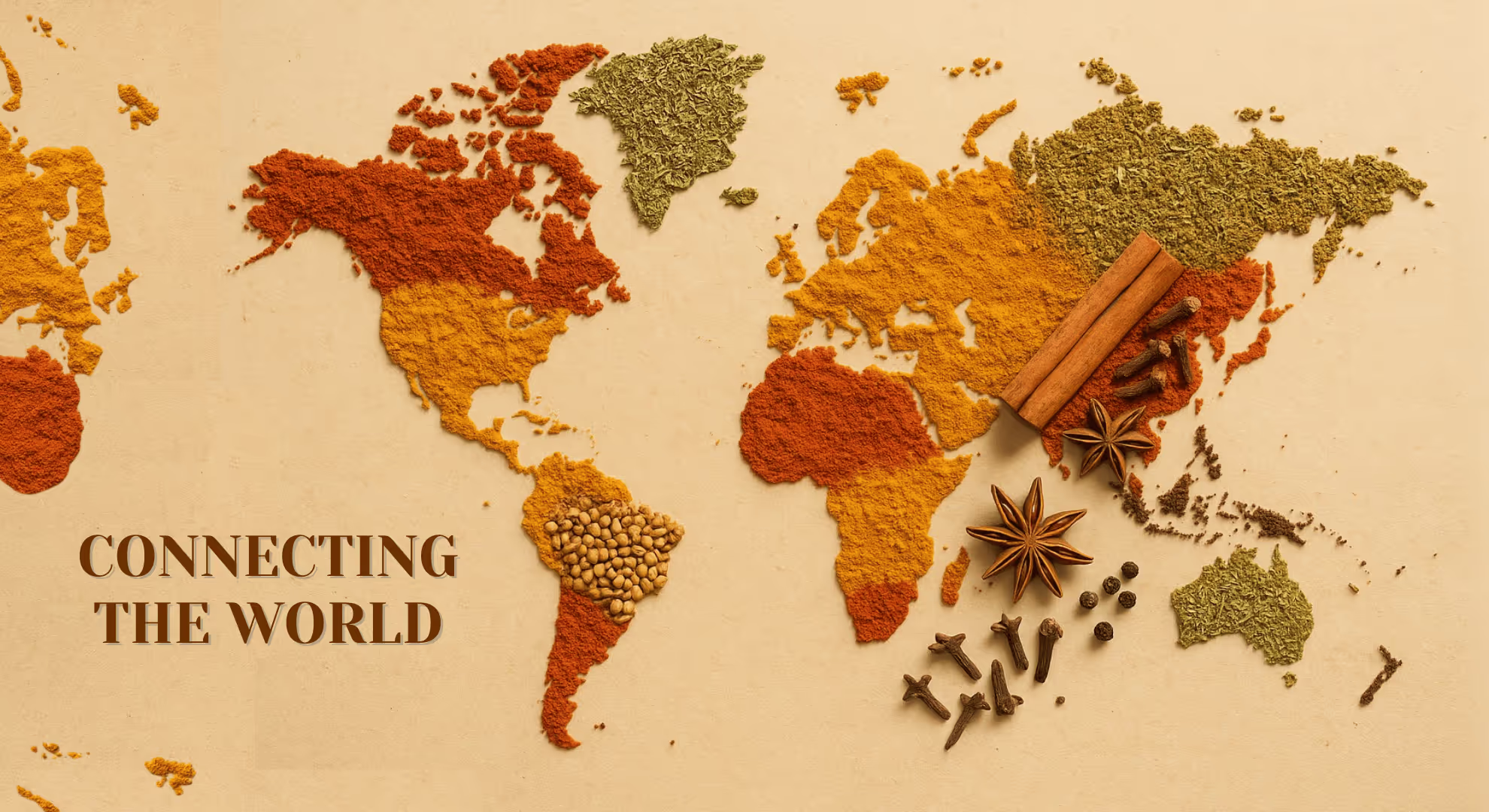

The veggie burger is a quintessentially American comfort food and this recipe offers a modern, flavorful alternative to traditional versions. The Indo-American fusion is found in the heart of the dish: a plant-based patty that is not only robust and satisfying but also rich with the aromatic profile of Garam Masala. This recipe is positioned for health-conscious individuals, young adults and families looking for a creative, protein-rich meal.
The flavor of this burger is built from the ground up by incorporating the spices directly into the patty mixture. While Garam Masala is often considered a finishing spice used for its mild aroma, its component spices like cloves, cinnamon and nutmeg are robust enough to withstand cooking and build the core flavor of the patty from the start. This creative application of the spice blend showcases its versatility beyond traditional Indian curries. The patty itself is crafted from a base of mashed chickpeas, grated beetroot, carrots and boiled potatoes, which collectively provide a satisfying texture and hold their shape well during cooking. To bind the mixture, bread crumbs or chickpea flour are used, ensuring the patties do not fall apart.
The key spices include Garam Masala for its fragrant notes, complemented by Cumin Powder and a touch of Red Chilli Powder for earthiness and a gentle heat. To prepare these burgers, the vegetables and chickpeas are finely mashed and combined with the spices, binders, and aromatics like finely chopped onion and garlic. The mixture is then formed into patties.
These can be pan-fried on a stovetop, baked or air-fried, offering multiple cooking options to the home chef. The final creation is served on a toasted bun with a tangy yoghurt-based sauce, fresh coriander and pickled onions.

This recipe redefines the beloved macaroni and cheese by infusing it with a rich, Indian spice tempering. It is a modern comfort food that appeals to a broad demographic, from children who adore mac and cheese to adults who appreciate complex flavors. The fusion is achieved by replacing the traditional béchamel roux with an Indian tadka or tempering, as the flavor base.
The culinary connection between creamy, cheesy mac and cheese and the rich gravy of North Indian cuisine is an intuitive one. This recipe begins by creating a masala base in butter or oil, a technique commonly used to unlock the flavors of Indian spices. The tempering consists of Cumin Powder, Turmeric Powder for a beautiful golden colour and earthy notes, Red Chilli Powder for a gentle heat, and Garam Masala for its signature fragrance. Into this seasoned butter, minced garlic and ginger are added and sautéed, further building the aromatic profile. This spice-infused butter mixture becomes the foundational element of the cheese sauce. A standard béchamel sauce is then prepared and the masala-tempered butter is incorporated, followed by a blend of cheeses to create a creamy and indulgent texture. This method of building the flavor base through a tadka is a transferable culinary principle that can be applied to many other creamy, Western comfort dishes.
The process involves cooking the macaroni, preparing the spiced butter and cheese sauce, and then combining the two. Garnish the finished dish with fresh coriander or crispy fried onions for an added layer of texture and freshness.
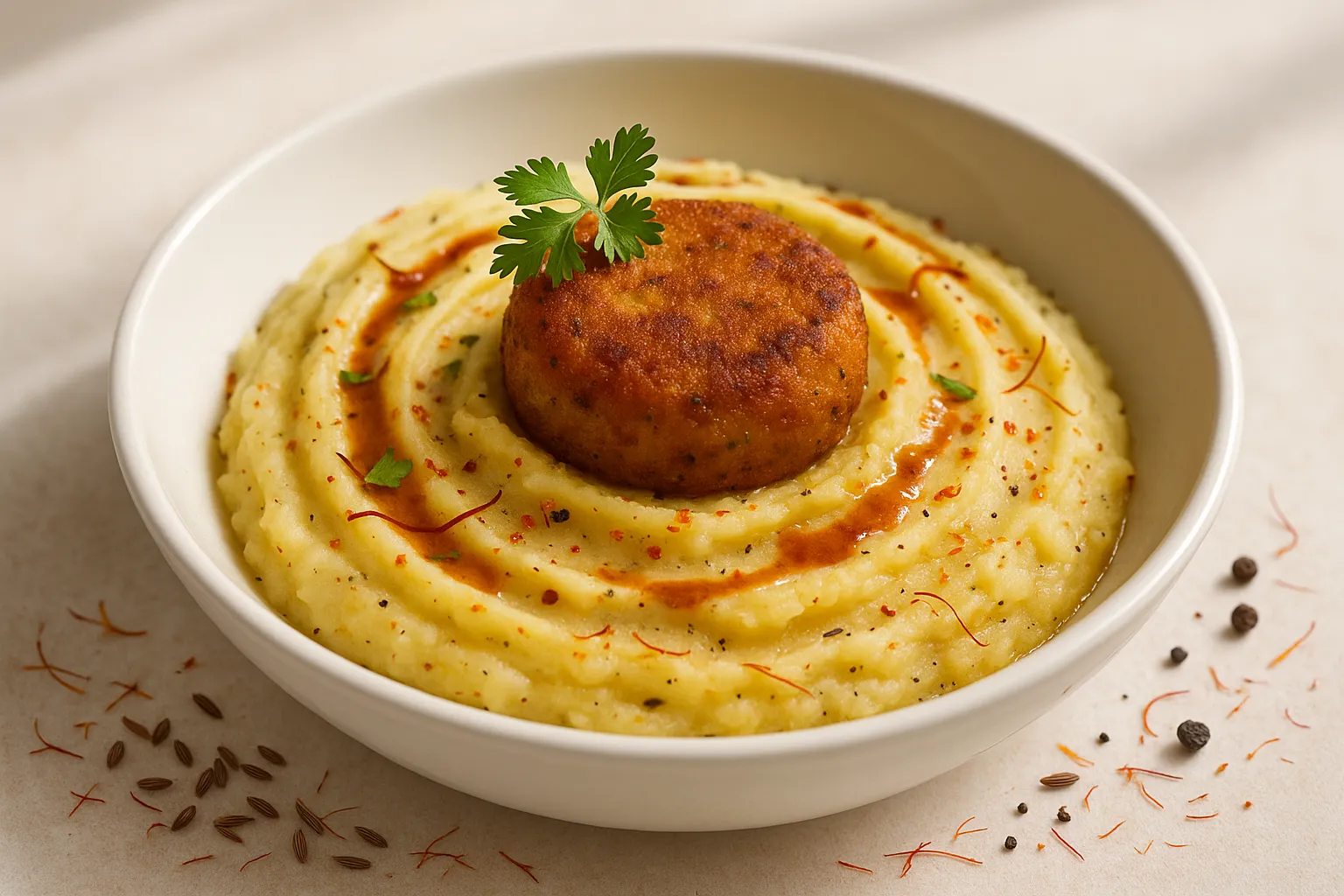
This recipe elevates the simple side dish of mashed potatoes by introducing the familiar, street-food-inspired flavor of a North Indian Aloo Tikki. This dish is designed to appeal to families and food enthusiasts looking for a creative, flavorful twist on a classic side. The creamy texture of mashed potatoes provides a perfect canvas for the spices, resulting in a dish that is both comforting and elegantly exotic.
The preparation of this fusion side dish combines the best of both worlds. The potatoes are peeled, chopped and boiled until perfectly soft, then mashed using a ricer or masher to ensure a velvety, non-gluey texture. While the potatoes are cooking, a crucial flavor infusion is created. A tempered mixture of Cumin seeds, Turmeric Powder, and Red Chilli flakes is prepared in melted butter or ghee. Finely diced red onion, green chilies and garlic paste are added to the butter, creating a fragrant base. After the potatoes are mashed, this spice-infused butter mixture is folded in along with warm cream or milk, ensuring the mash is evenly coated and turns a beautiful yellow colour from the turmeric.
This strategic use of a tadka is a fundamental Indian cooking technique, but here it is presented in an accessible way for a Western dish, educating the consumer on a core culinary principle. The final result is a vibrant, flavorful side dish that is a natural pairing of two beloved potato preparations. The finished dish is garnished with fresh coriander or green onions.
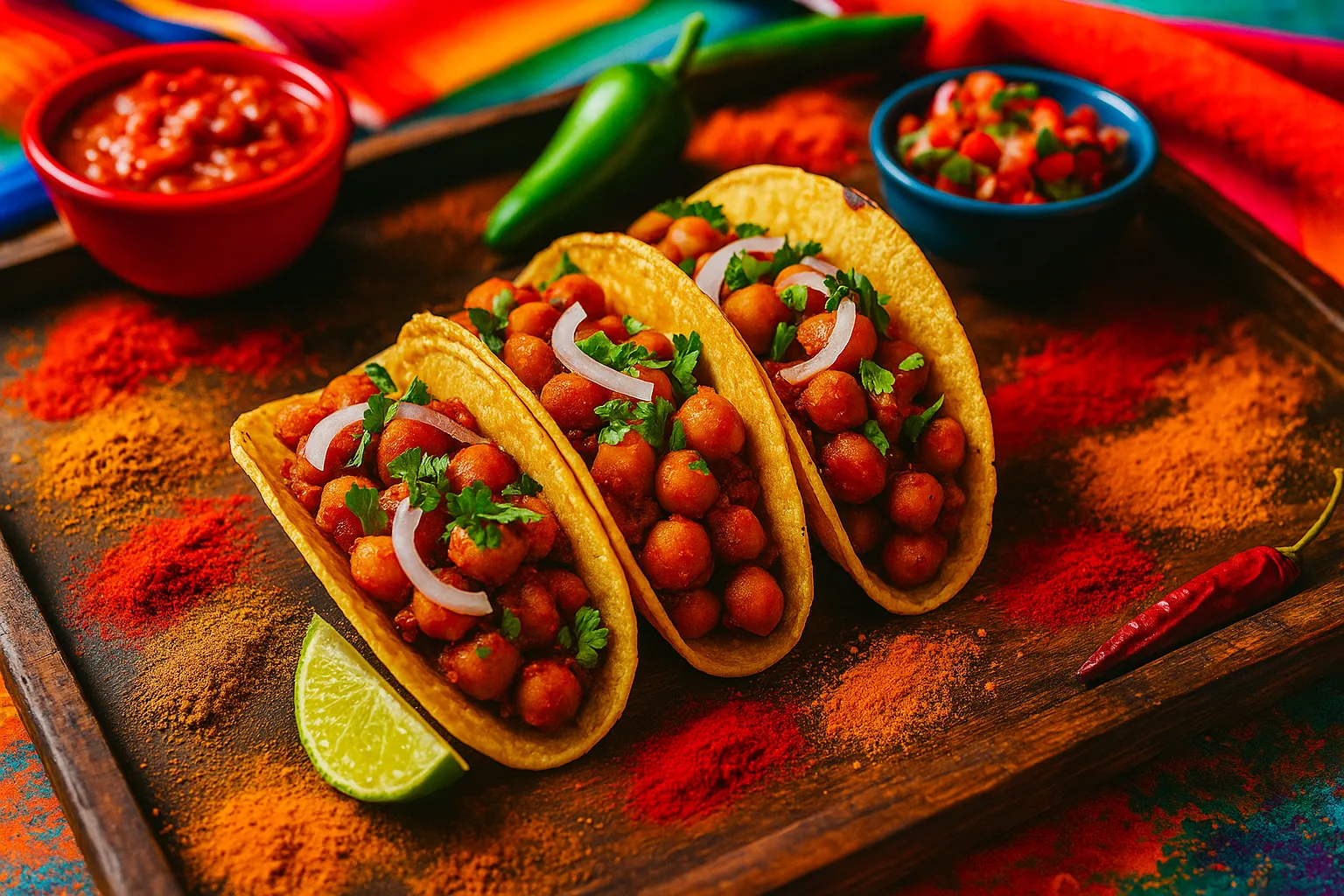
This recipe offers a playful and flavorful fusion of Indian chana masala and Mexican tacos, celebrating the commonalities between the two cuisines, such as a love for bold spices and fresh, tangy flavors. This dish is aimed at younger, trend-conscious consumers and families who enjoy vibrant, shareable meals.
The preparation begins with a traditional chana masala filling, which is then adapted for a new format. The classic chana masala recipe uses Chana Masala powder as a key ingredient, along with a base of Cumin seeds, Red Chilli Powder, Turmeric, and a tomato-onion gravy. The real fusion, however, lies in the adaptation of the dish's texture. A traditional chana masala is a saucy curry, but a taco filling must be more cohesive to be eaten by hand.
The recipe includes the crucial step of mashing the chickpeas with a potato masher, creating a texture similar to a refried bean filling. This structural re-engineering of the dish demonstrates a deep understanding of culinary adaptation. The chana masala filling is then served on corn or flour tortillas and topped with fresh, zesty ingredients like a cucumber salsa, chopped onions and fresh coriander.
The dish can be further customised with toppings like avocado, cheese or a cilantro-yoghurt sauce. This dish not only provides a delicious new way to enjoy chana masala but also showcases our Chana Masala as a versatile product capable of transcending its traditional role.
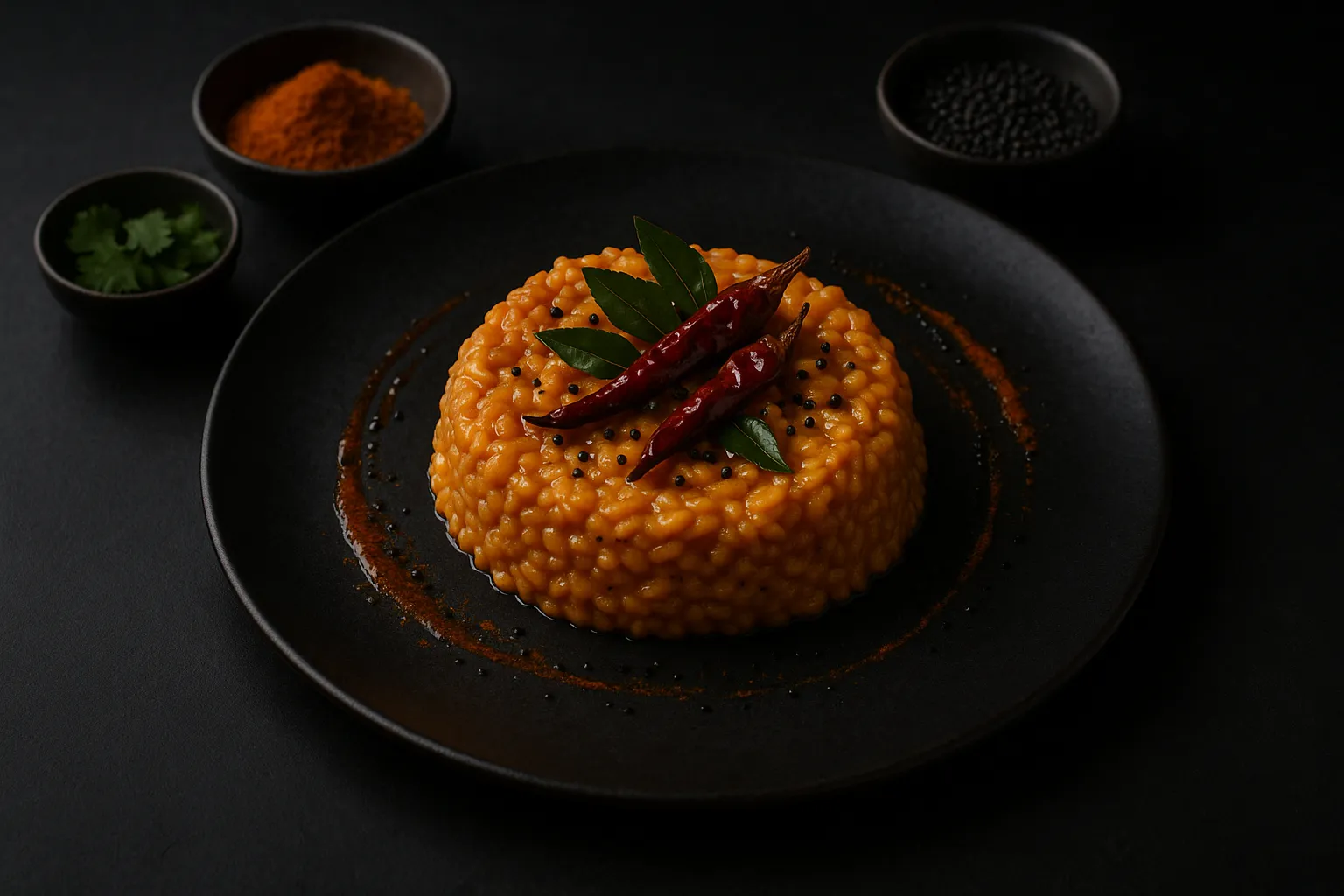
This recipe is a sophisticated and elegant fusion that marries the creamy, slow-cooked technique of Italian risotto with the tangy, aromatic complexity of South Indian sambhar. It is designed for foodies and adventurous home cooks who enjoy exploring creative culinary combinations.
The idea for this dish is rooted in the fact that a traditional sambhar, a lentil and vegetable stew, can itself be described as a “risotto-like” dish. This recipe takes that concept a step further by using the Italian risotto method as the cooking process. The dish begins with a classic soffritto of onions, garlic, and ginger. Instead of adding wine and a standard broth, the rice is toasted with a generous amount of Sambhar Masala and a touch of Turmeric Powder for colour.
This step fundamentally transforms the flavor base of the dish. Vegetables common in sambhar, such as carrots, green beans and cauliflower, are then added and a broth made with vegetable stock, cooked toor dal and a small amount of tamarind paste is gradually incorporated as the rice slowly cooks to a creamy consistency. This method re-engineers the traditional sambhar process, where dal and veggies are cooked separately, into a single, cohesive cooking experience.
The final touch is a tempering or tadka, of mustard seeds, curry leaves and red chilies in ghee or oil, which is poured over the finished risotto, just as it would be for a traditional sambhar. This finishing step adds a layer of fragrant warmth and texture, making the dish a true South Indian-Italian creation.
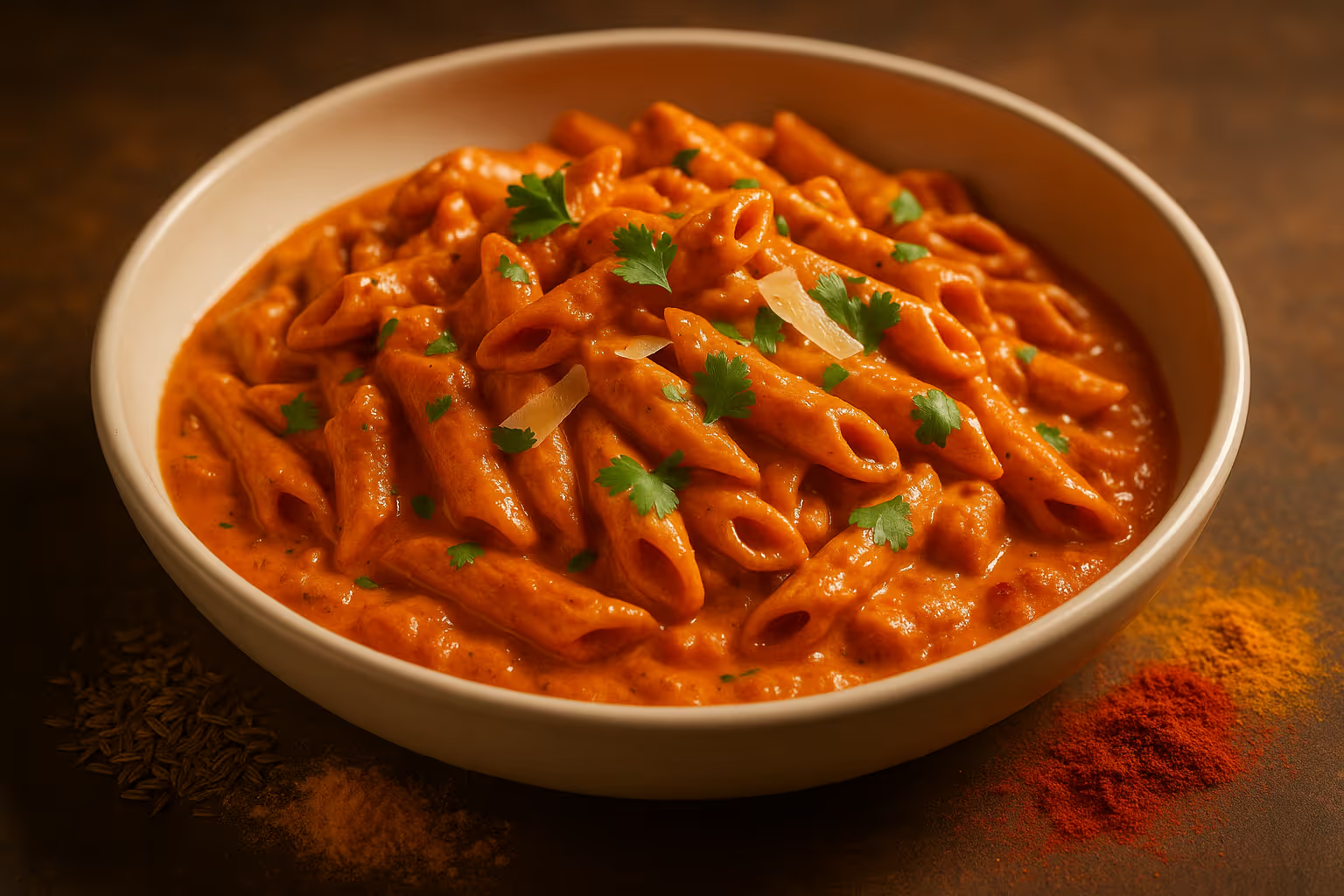
This recipe represents a highly successful and widely popular fusion dish that combines the creamy, mildly spiced flavors of a Tikka Masala curry with Italian pasta. It is a reliable "gateway" to fusion cuisine, appealing to virtually everyone, including families, children and those who may be new to Indian flavors.
The recipe’s success lies in its harmonious flavor profile. The sauce is built on a creamy tomato base, which is thickened with full-fat coconut milk to create a rich and luscious texture. This creamy base is infused with a well-balanced mix of spices, including Garam Masala, Coriander Powder, Cumin Powder and Turmeric Powder. The sauce’s depth comes from a foundation of sautéed sweet onion, fresh garlic and grated ginger, which are cooked until fragrant before the spices are added.
The mild, aromatic nature of the spices makes the dish universally appealing, as it shares flavor notes with many creamy curries that are already familiar to a global audience. The sauce is prepared in a single pan, which simplifies the cooking process. A short pasta shape like farfalle or penne is recommended, as it holds the sauce well.
The pasta should be cooked to a firm "al dente" stage, as it will continue to cook slightly when combined with the warm sauce. This recipe not only provides a delicious meal but also serves as an excellent example of how a popular Indian flavor profile can be successfully applied to a Western dish, making it a cornerstone for the brand's website.
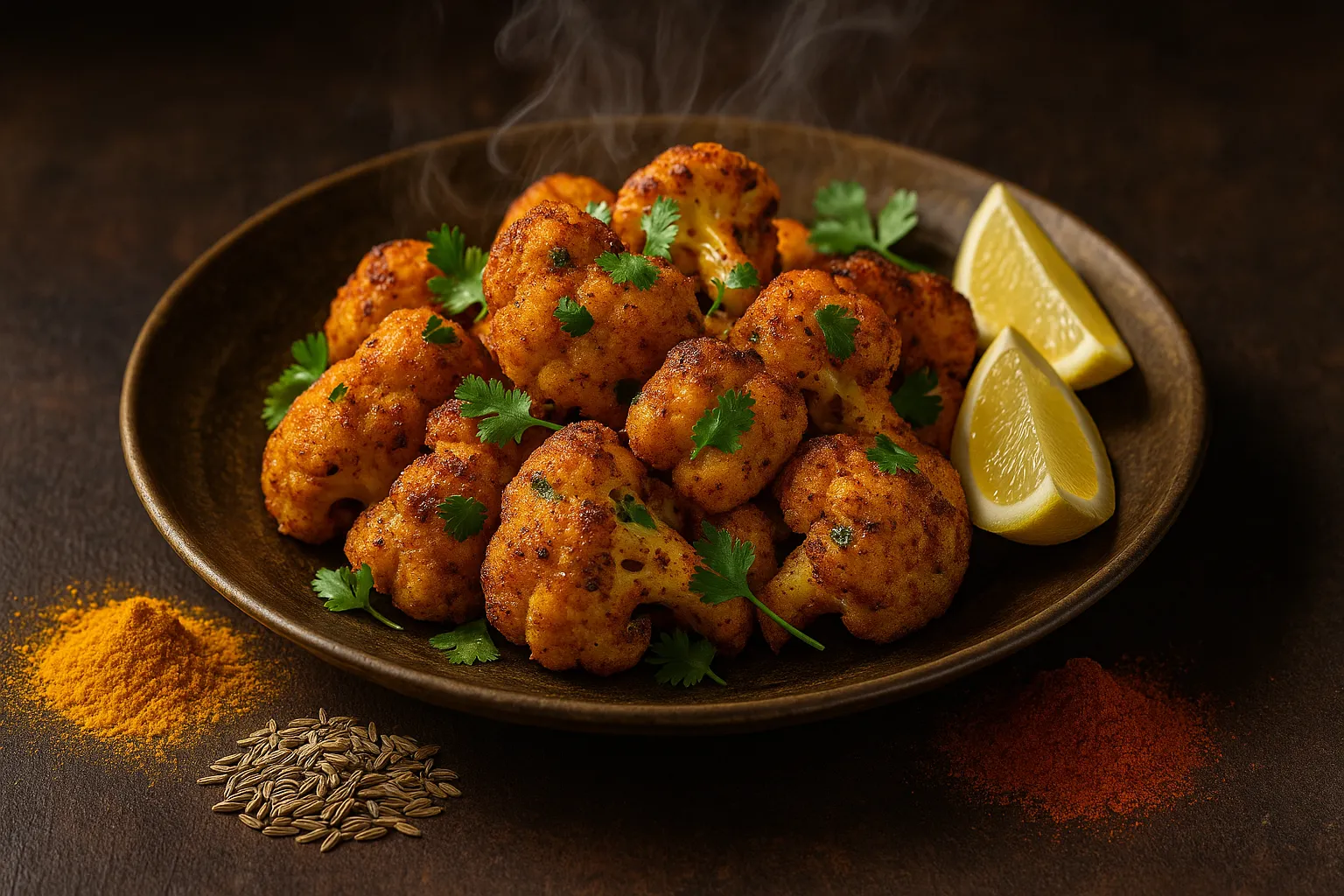
This recipe offers a simple yet addictive roasted vegetable dish that uses the all-in-one Kitchen King Masala to create a complex and flavorful snack. It’s a perfect choice for health-conscious individuals, families, and anyone looking for a quick and easy appetiser.
The fusion here combines a Western cooking technique — oven roasting — with an all-encompassing Indian spice blend. The key to this recipe’s simplicity and depth of flavor is Kitchen King Masala, which is specifically designed to be added during the cooking process to release its full aroma and taste. This makes it uniquely suited for Western methods like roasting and stir-frying, where spices are cooked along with the food.
The blend contains a wide range of spices that would normally need to be measured individually, allowing home chefs to achieve a complex flavor profile with just one product. The primary ingredient is cauliflower florets, which, when roasted, turn crispy on the outside and tender on the inside. Other vegetables like potatoes, carrots or broccoli can also be used.
To prepare the cauliflower bites, the florets are coated in olive oil, a sprinkle of salt, a dash of lemon juice, and Kitchen King Masala. A touch of turmeric powder can be added for a vibrant golden color. The seasoned florets are then roasted at a high temperature until caramelised and slightly charred, resulting in a snack that is both healthy and irresistible.
These bites are delicious served on their own or paired with a refreshing yoghurt-based dipping sauce.
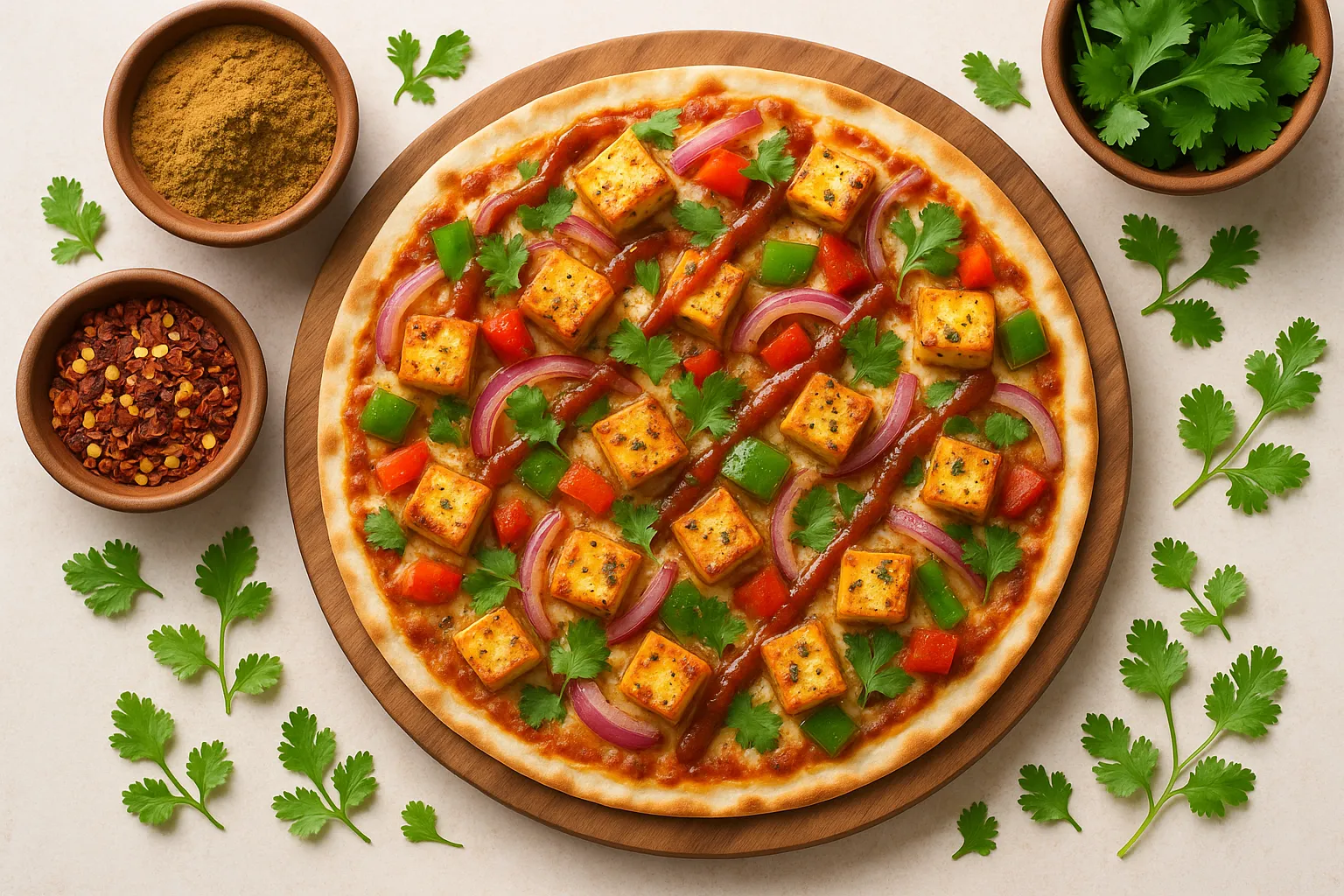
This recipe presents a quick and easy flatbread pizza with an Indian-inspired masala marinara sauce. It is an ideal meal for younger generations, students and busy families who want a fast, customizable and flavorful dish. The fusion is in the re-engineering of a core pizza component: the sauce.
The narrative behind this recipe positions the flatbread pizza as a "blank canvas" for flavor exploration. The most successful fusion recipes fundamentally re-imagine a core component of the dish and in this case, that means infusing a simple marinara sauce with Indian spices.
A store-bought or homemade tomato sauce is transformed into a rich, aromatic base with a sautéed mixture of garlic, ginger, Cumin Powder, Red Chilli Powder and Turmeric Powder. This method creates a deeply integrated fusion experience rather than simply sprinkling a spice blend on top. The recipe suggests using a store-bought flatbread or pre-made pizza dough for ease and speed.
Toppings can be chosen to complement the Indian flavors such as spiced chickpeas, paneer, onions and bell peppers. Mozzarella cheese or a vegan alternative can be used to maintain the classic pizza feel.
The final dish is baked until the cheese is melted and bubbly, providing a fast yet flavorful meal that is highly customizable and universally appealing.
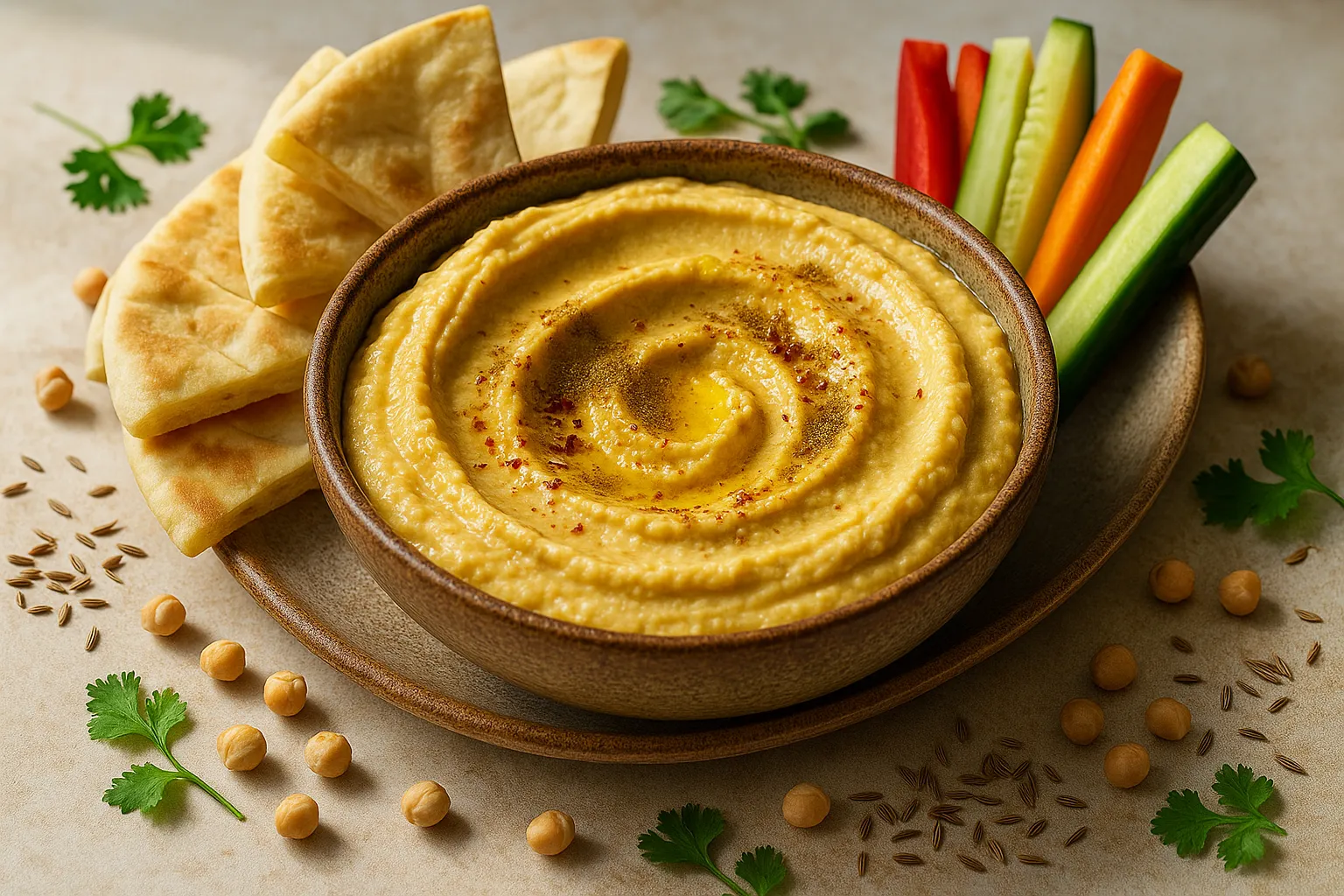
Hummus is a universally loved Mediterranean classic and this recipe offers a fresh, vibrant and healthy twist by featuring the bright, citrusy notes of Indian spices. The dish targets health-conscious consumers and hosts looking for an easy, impressive dip.
The flavor profile is re-imagined by shifting the dominance of Cumin to the more floral and citrusy Coriander Powder. The preparation follows the standard hummus method, blending cooked chickpeas with tahini, lemon juice and garlic. However, to create a distinct Indian flavor, the recipe features Coriander Powder as the primary spice with a touch of Cumin Powder to add an earthy balance. A whisper of Red Chilli Powder can be included for a gentle hint of heat.
This creative substitution of a key ingredient demonstrates how a single spice can completely alter a dish's identity while maintaining its integrity. The resulting dip is vibrant and flavorful. The process is simple, involving blending all the ingredients until smooth and creamy.
The finished masala hummus is garnished with a drizzle of olive oil, a sprinkle of paprika and fresh coriander, and can be served with pita bread, vegetable sticks or even as a spread on toast. This recipe showcases the versatility of a single spice and encourages the consumer to experiment with flavor substitutions to create their own unique fusion dishes.
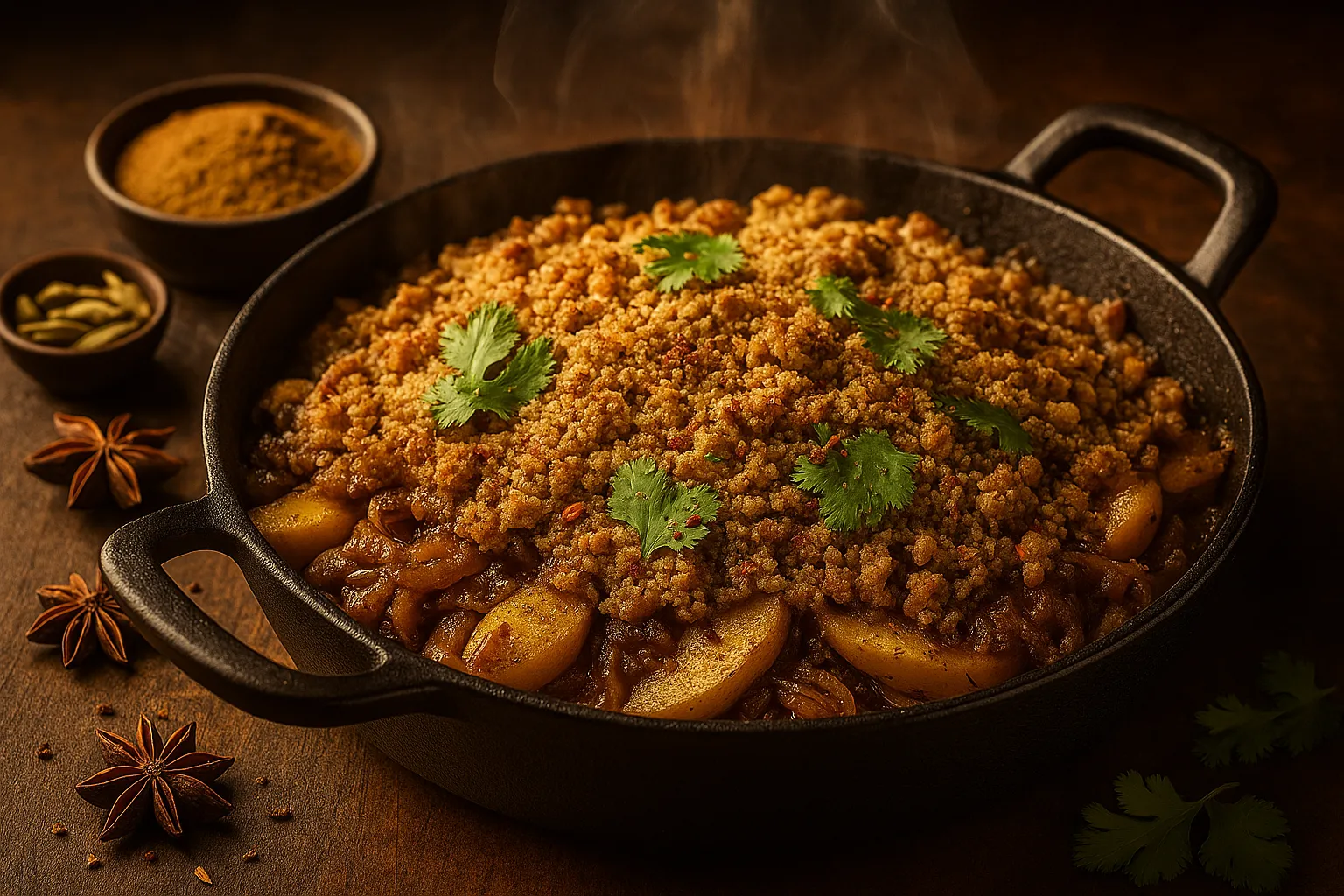
This recipe is a delightful and unexpected fusion that brings together the comforting charm of a Western apple crisp with the warming, aromatic depth of Garam Masala.
It is designed for adventurous home bakers who enjoy surprising guests with a unique flavor twist. The brilliance of this fusion lies in the natural connection between the spice profiles. Garam Masala is built from familiar “warming” spices like cinnamon, cloves, and cardamom — all of which already play a starring role in traditional Western desserts.
Instead of introducing a foreign element, this recipe subtly extends a familiar flavor. The apple filling is prepared in the standard way, but rather than using only cinnamon, a pinch of Garam Masala is added. This infusion gives the apples a new aromatic warmth while keeping them comfortingly familiar.
A classic crumble topping — made of oats, flour, sugar, and butter — is then spread over the spiced apples. The dish follows the traditional apple crisp method: preparing the filling, layering with the crumble, and baking until golden and bubbling.
The result is a warm, fragrant dessert that pairs beautifully with a scoop of vanilla ice cream. This recipe not only delights the palate but also challenges assumptions about how Indian spices can be used — encouraging bakers to experiment with new, creative combinations.
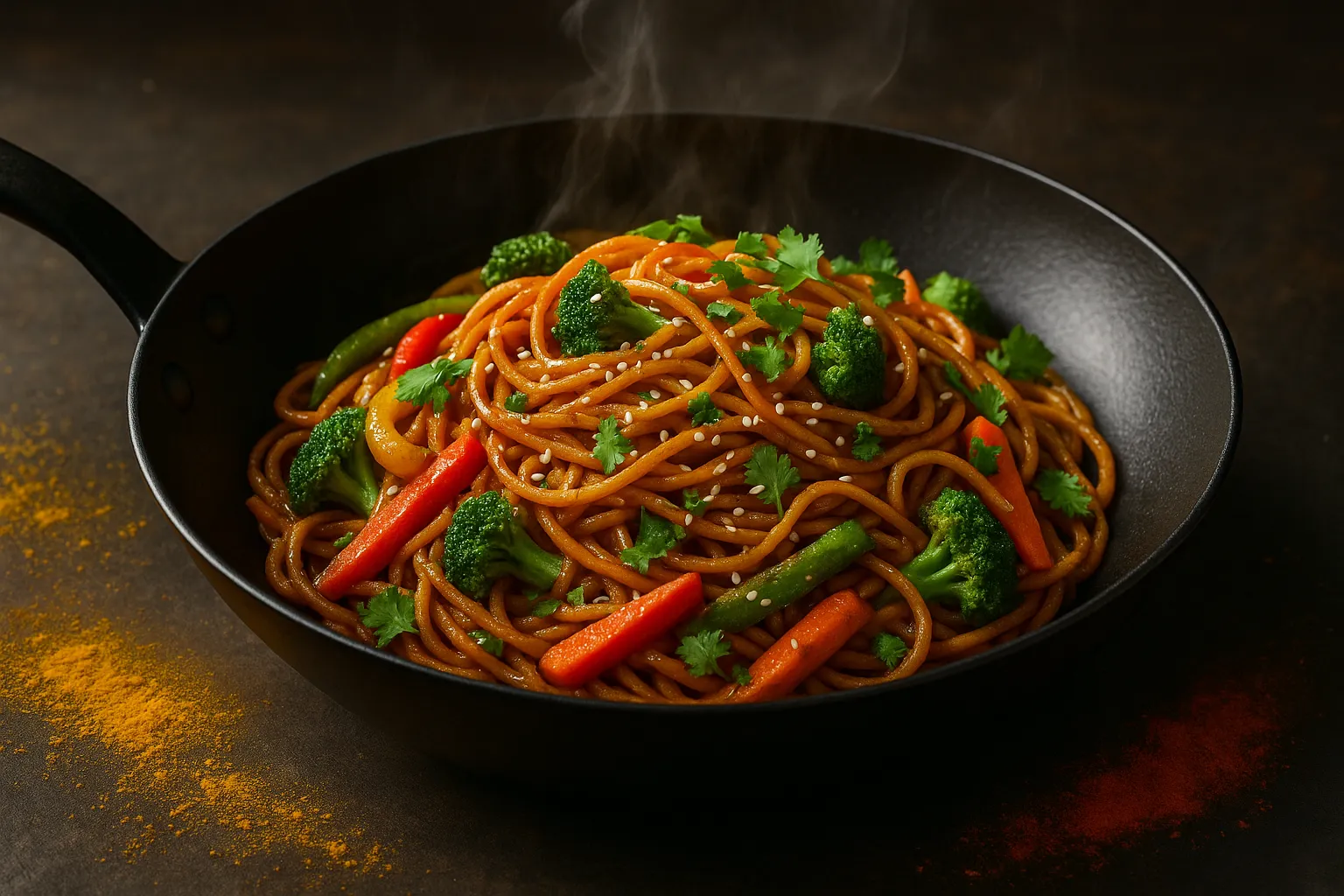
This recipe is a quick, healthy, and versatile weeknight meal that brings together vibrant stir-fried vegetables and noodles, elevated by the all-in-one flavor of Kitchen King Masala. Perfect for busy professionals, students, or anyone craving a fast yet satisfying dish, this fusion offers an approachable Indo-Chinese twist while simplifying the cooking process.
The magic of Kitchen King lies in its ability to act as a complete seasoning blend, eliminating the need for multiple spices. Research shows it’s particularly effective for vegetable stir-fries, especially when added early in the cooking process to toast and unlock its rich flavor base.
In this recipe, fresh vegetables like broccoli, mushrooms, carrots, and bell peppers are quickly stir-fried with garlic and ginger. Kitchen King Masala is then added to infuse the dish with its bold, layered taste. Once the vegetables reach a crisp-tender texture, cooked noodles or rice are tossed in, creating a wholesome, flavorful meal in minutes.
To finish, garnish with fresh coriander, a squeeze of lime juice, or toasted sesame seeds for an extra burst of freshness.
This recipe showcases the practicality and marketability of Kitchen King Masala, positioning it as the go-to seasoning for anyone looking to prepare delicious, convenient meals with minimal effort.
The collection of recipes presented in this report serves as a testament to the boundless creativity and versatility that can be achieved when different culinary traditions converge. From the comforting warmth of a Garam Masala burger to the surprising delight of a Sambhar risotto, each dish redefines flavor by blending the familiar with the exotic.
The recipes demonstrate that spices are not confined to their traditional roles; they are dynamic tools that can be used to build flavor, create unexpected harmonies, and transform a simple dish into an extraordinary experience.



